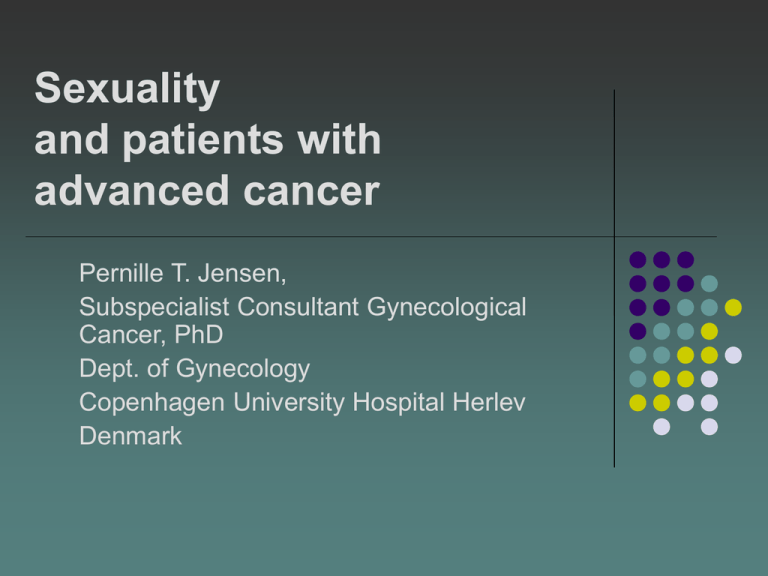
Sexuality
and patients with
advanced cancer
Pernille T. Jensen,
Subspecialist Consultant Gynecological
Cancer, PhD
Dept. of Gynecology
Copenhagen University Hospital Herlev
Denmark
Agenda
Cancer and treatment related potential
negative impact on the female and male
sexual response in cancer patients
Gynecological cancer
Rectal/anal/bladder cancer
Prostate cancer
Surgery and radiotherapy
Practical issues in handling sexual problems
Future perspectives
2
Agenda
Cancer and treatment related potential
negative impact on the female and male
sexual response cancer patients
Gynecological cancer
Rectal/anal/bladder cancer
Prostate cancer
Surgery and radiotherapy
Practical issues in handling sexual problems
Future perspectives
3
Agenda
Cancer and treatment related potential
negative impact on the female and male
sexual response cancer patients
Gynecological cancer
Rectal/anal/bladder cancer
Prostate cancer
Surgery and radiotherapy
Practical issues in handling sexual problems
Future perspectives
4
The sexual response
The Brain
Knowledge and fantasy
3. Break point
Distraction, spectator
Feelings
Love, trust and intimacy
The Body
Sexual enjoyment
2. Breakpoint
Anxiety, fear of failing,
anger and grief
1. Breakpoint
Pain, insufficient stimulation
5
Pelvic autonomic nerves and relation
to central nerve system
Brain
Visual input
T10-T12
Superior Hypogastric plexus
S2-S4
Splanchnic nn.
Pudendal nerve
Sensory input
Inferior Hypogastric plexus
• Rectum
• Ureter, bladder and urethra
• Penis, seminal vesicals
• Uterus, vagina, clitoris
6
Male sexual function
Brain
Visual input
T10-T12
Superior Hypogastric plexus
S2-S4
Splanchnic nn.
Pudendal nerve
Sensory input
Parasympathetic
activity maintain
erection
Sympathetic
outflow causes
smooth muscle
contraction
leading to
ejaculation
Inferior Hypogastric plexus
• Rectum
• Ureter, bladder and urethra
• Penis, seminal vesicals
7
Female sexual function
Brain
Visual input
T10-T12
Superior Hypogastric plexus
S2-S4
Splanchnic nn.
Pudendal nerve
Sensory input
Parasympathetic
activity maintain
vasocongestion
Sympathetic
outflow maintain
lubrication and
causes smooth
muscle
contraction
leading to
orgasm
Inferior Hypogastric plexus
• Rectum
• Ureter, bladder and urethra
• Vagina, clitoris and uterus
8
9
Important to remember..
Pelvic late effect of surgery and radiation will
mimic those that we have data for!
Despite efforts to reduce the surgical trauma
by using laparoscopic techniques, pelvic
nerve injuries are very common
Individual differences in late effects after
radiotherapy
10
Radiation effect on
vulva/vagina
The rapid cell-turnover in vaginal mucosa makes it vulnerable to
radiation effects
Submucosal bleeding
Confluent mucositis
Depridement
Fibrino-purulent exudation
Hypoxia og necrosis
Late complications
Thin and vulnerable vaginal mucosa and skin in vulva
Fibrosis
Narrow vaginal entrance
Narrow vagina with decreased elasticity
Different levels of vaginal stenosis
11
Female Sexual dysfunction
(FSD)
Sexual desire disorders / reduced sexual interest
Sexual arousal disorders
Reduced/inhibited vaginal lubrication
Reduced subjective feeling of being aroused
Orgasmic disorders
Premature, delayed or absent orgasm following a
normal excitement phase
Sexual pain disorders
Dyspareunia
Vaginismus
12
Male sexual dysfunction
•
Erectile dysfunction
(ED)
•
•
Neurogenic
Vascular
Psychologic
Painful erection
Priapism
Orgasmic disorders
•
•
•
Delayed or absent
orgasm
Premature ejaculation
Retrograd ejaculation
Sexual pain disorders
Sexual desire disorders
13
Gynecological cancer and sexual
dysfunction
body
image
Impaired sexual
function
Less
attractive
Less
feminine
Vaginal
dryness
Age
Stage of
disease
Menopause
Fatigue
Fear of
recurrence
Vaginal
shortening
Dyspareunia
Cancer
treatment
Depression
Fear of
dying
Anxiety
Worries
14
The impact of hypoactive
sexual desire disorder on life
15
Sexuality in a palliative setting
Independent on age, gender, diagnosis,
cultural background, and partner status:
Very reflective about their need to talk about
sexuality
HCP’s ignored their need for staying intimate and
sexual with their partner
Dismissed when they were seeking information,
advice and emotional support about bodily and
psychosexual changes
16
Horden AJ et al (2007) Soc. Scien Med 64:1704-1718
Palliative HCP’s
Lacking time..
Too private
The patient mainly want to discuss his
cancer
Afraid of being misunderstood
Afraid of being condemned by other
patients and the staff
17
Horden AJ et al (2007) Soc. Scien Med 64:1704-1718
Two Danish multi-center studies
Hvidovre
Hospital
Næstved
Hospital
Herlev
University
hospital
Cph University
hospital
Patients with advanced
cervical cancer
Patients with early stage
cervical cancer
Radical hysterectomy + pelvic
lymphadenectomy
Primary EBRT +
brachytherapy
Radical hysterectomy +
pelvic lymphadenectomy +
EBRT
18
Design
Extended
SVQ
Sociodemografic
data
0
1
3
Patients with
persistent
disease
excluded
6
12
18
24
Mths
QLQ-30
UGQ
SVQ
19
Control group
Danish women randomly selected from the
Danish Central Population Register
Born on the same date in odd years from
1913 til 1971
Age-matched
2 control women / patient
20
Advanced cervical cancer
1m
3m
6m
12m
18m
24m
Sexual interest
Not at all–a little
90%
RR 1.5
84%
RR 1.4
Lack of lubrication
Quite a bit–very much
28%
RR 5.3
28%
RR 5.3
Dyspareunia
Quite a bit–very much
27%
RR 7.6
Orgasm
Never-occasionally
67%
RR 1.6
15%
RR 4.4
63%
RR 1.6
21
Jensen PT et al IJROBP 2003
Advanced cervical cancer
1m
3m
6m
12m
18m
24m
Size of vagina
bothersome during
intercourse – too small
49%
RR 5.6
42%
RR 4.8
Able to complete sexual
intercourse
Never-occasionally
61%
RR 3.5
43%
RR 2.4
Not sexually active
50%
RR 2.0
Partner’s interest in
sexual relations
Not at all-a little
53%
RR 1.3
Dissatisfied with sexlife
30%
RR 2.0
47%
RR 2.0
28%
RR 221.8
Retrospective comparison
% scorings
Changes since cancer
diagnosis
Improved
No
change
Deterioated
p
0
39.1
60.9
<0.001
Vaginal lubrication
4.2
33.3
62.5
<0.001
Dyspareunia
16.7
27.8
55.6
0.05
Size of vagina
4.01
48.0
48.01
0.002
6.5
58.7
34.8
0.003
0
86.8
13.2
0.03
Sexual interest
1
”larger” ,”no change”, ”smaller”
Interest in intimacy
Partner’s sexual interest
23
Conclusion
Risk of FSD after radiotherapy for
cervical cancer
Patients who are disease free after radiotherapy for
advanced cervical cancer are at high risk of
experiencing persistent sexual and vaginal problems
Poor improvement over time
The results may underestimate the degree of sexual
problems for the group of cervical cancer patients in
general
24
Vulvectomi – partial or total +/plastic surgery
25
Sexual rehabilitation after vulva cancer
Concern about continuation sexual relationship
Have to cope with husband’s poor coping
Insecure of anatomical changes
50% will become sexual inactive
Most pts will have severe FSD
Most pts have complaints re narrow vaginal entrance,
impaired sensitivity, orgasmic and lubrication problems
Result of sexual rehabilitation presumably depends
highly on pre-surgery information given to the couple
Weijmar Schultz et al. J psychosom obstet gynecol261986
Green MS Gynecol Oncol 2000
Rectal cancer og FSD
27
Bruheim K Acta Oncologica 2010; 49:820-32
Rectal cancer og FSD
Lack of sexual interest – 41%
Reduced arousal – 29%
Lack of lubrication – 56%
Orgasmic problems – 35%
Dyspareunia – 46%
53% rapported new sexual problems not present before the
operation
61% rapported poorer sexual functioning than an age matched
control group
61% was sexually active before the operation decreasing to 32%
after the operation
28
Prostate cancer og ED
After definitive treatment
At diagnosis
30-50% ED
Surgery +/- RT
60-80% ED
If further anti-androgen
treatment is given
80-90% ED
29
Prostate cancer, Sexual
dysfunction and the partner
High incidence of sexual dysfunction both in patients and
their spouses; highly correlated
A higher prevalence of sexual dysfunction in couples
with marietal problems.
A higher prevalence in couples that communicate poorly
A high correlation between the quality of the sexual
relationship before and after the cancer
Of great importance for both spouses that their partner is
sexually satisfied
30
Treatment
Communication (therapy) with the patient and the partner
Pharmacological
Hormone replacement therapy (locally and/or systemically)
Phosphodiesterase inhibitors (e.g. Viagra)
Tibolone
Testosterone
Prostaglandine locally
Aids
Lubricants
Replens
Vaginal dilators
Vibrator
Penile transplants
31
Local Estrogen
Vaginal
tablets
Vaginal
ring
Vaginal
creme
32
Cochrane review (2006)
19 randomised studies
4162 postmenopausal women
Prim. endpoint: vaginal atrophia / vaginitis
Significant effect of the creme, ring and
tablets vs placebo
No difference in the effect of the 3
methods of application
More side effects of the creme
Women prefer the ring
33
Vaginal Estrogen to endometrial
and breast cancer patients?
No evidence of endometrial proliferation with 6-24
mths use
No evidence to support yearly endometrial biopsy
No evidence to support additional progesterone
No studies have found increased risk of recurrence
after vaginal estrogen in breast and endometrial
cancer patients
All application methods reaches very quickly steady state
serum level concentrations below that of menopausal
women (< 50pmol/l)
34
Vaginal moisturizer
35
The effect of Replens
•
Replens is a polycarbofil
which binds to the
vaginal epithelium cells
and maintains hydration
leading to
Improvement in
• vaginal fluid volume
• moisture
• elasticity
36
The effect of Replens
•
The elasticity of the
vagina improves
•
The natural pH og the
vagina is restored
•
The physical discomfort
disappears
•
Dyspareunia diminishes
37
HRT + / - Testosterone
No increased risk of cardio-vascular events or breast
cancer of HRT when given to women with surgical
premature menopause (up to the age of ~ 50)
No increased risk by adding testosterone (2 yrs. results)
A significant positive effect of HRT on sexuality in
gynecological cancer patients (cervix and ovarian
cancer)
A significant improvement in sexual desire in healthy
menopausal women when testosterone is added to
Estrogen preparations
38
Schufelt C et al Maturitas 2009, Al-Azzawi F et al Climacteric 2010, David S et al. NEJM 2008
HRT
REMEMBER systemic HRT
After induced premature menopause with nonhormone dependent tumors
After pelvic radiation, especially for those with
induced menopause
No increased risk of recurrence for non-hormone
dependent tumors
39
Lubricants
40
Dilators
41
Vaginal dilation (hegar)
No international guidelines and a sparse evidence
for the effect
One randomised controlled study on the use of
hegar
Increased compliance with hegar use and reduced fear for
having sex after cancer treatment, independent of age
The intervention included psychoeducational group
counseling on vaginal dilatation and provided advice,
proposals and information about sexual function and praxis
42
Robinson JW et al. IJROBP 1999
National forum of gyn.onc.
Nurses (2005)
“Best practice guidelines on the use of vaginal
dilators in women receiving pelvic radiotherapy”
Minimum 3 times/week
Water soluble lubricant
Supine or standing with one leg on a chair
A light pressure at insertion to the vagina
Each application should last 5-10 min
Move the dilator in different directions and rotate it if
possible
Try different sizes, start with the smallest one
Rotate it again when removing
43
PDE5, prostate cancer and ED
44
Future directions
Sexuality is important for most cancer patients and cancer and its
treatment may have a devastating effect on sexuality
HCP will have to improve re communication and handling of
sexual complications after treatment
Sexuality has no age and no religion
HCP have to learn how to deal with patients’ sexual concerns
and worries
The health care professionals decide what is on the agenda
HCP should be aware that they have an outstanding possibility to
increase the QOL of cancer patients by communicating about
sexual dysfunction following cancer treatment
45
One would certainly think that there could be no doubt
about what is to be understood by the term ”sexual”.
First and foremost, of course, it means the ”improper”,
that which must not be mentioned..
Freud, 1943
46









